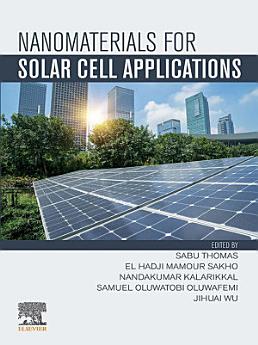Nanomaterials for Solar Cell Applications
Giới thiệu về sách điện tử này
Giới thiệu tác giả
Sabu Thomas is a Senior Professor of Mahatma Gandhi University, Kottayam, Kerala, India, and also Chairman of the TrEST Research Park, Trivandrum, India. He is known for his outstanding contributions in polymer science and nanotechnology.
Dr. El Hadji Mamour Sakho received his PhD degree in Applied Physics from Mahatma Gandhi University, India in 2016. Currently he is a postdoctoral fellow in the Department of Applied Chemistry, University of Johannesburg, South Africa under the supervision of Prof. SO Oluwafemi His research focus is on the synthesis and characterization of graphene based hybrid materials for different applications such as solar cells, batteries, nonlinear optical applications, sensors, photocatalysts and polymer nanocomposites.
Dr. Nandakumar Kalarikkal is an Associate Professor at the School of Pure and Applied Physics and Joint Director of the International and Inter University Centre for Nanoscience and Nanotechnology of Mahatma Gandhi University, Kottayam, Kerala, India. His research activities involve applications of nanostructured materials, laser plasma, and phase transitions. He is the recipient of research fellowships and associateships from prestigious government organizations such as the Department of Science and Technology and Council of Scientific and Industrial Research of the Government of India. He has active collaborations with national and international scientific institutions in India, South Africa, Slovenia, Canada, France, Germany, Malaysia, Australia, and the United States. He has more than 130 publications in peer-reviewed journals. He also co-edited nine books of scientific interest and co-authored many book chapters.
Professor Oluwafemi is a fully-fledged academic that is involved in Teaching & Learning, Research, Community Engagement, staff and student mentorship among many other activities. His research interest is in the synthesis of binary, ternary and quaternary semiconductor nanomaterial and nanostructures such as quantum dots, metal nanomaterials, core-shells, doped nanostructures and polymer nanocomposites for different applications which includes biological, (basically for cancer treatment ie imaging, labelling, drug delivery photodynamic therapy and photothermal therapy), optical (development of optical devices), environmental (sensing and determination of environmental pollutants), nanotoxicology and water treatment. He is also involved in the indigenous knowledge system (IKS) for value added chain using different South African medicinal plants. This involves isolation, extraction, biological activity testing, and synthesis of nanomaterial using the plant extract and packaging for pharmaceutical purposes.
Jihuai WU is a Professor of Chemistry and Materials and the Vice-president at Huaqiao University, China. He obtained his Master degree in Materials in 1988 at Huaqiao University, China, and obtained his Ph. D. degree in Chemistry in 1999 at Fuzhou University, China. He then joined the Institute of Materials Physical Chemistry, Huaqiao University in 1988m and was subsequently promoted to Associate Professor in 1994 followed by Professor in 1998. He was appointed the director of the Institute in 1998 and the current position of Vice-president in 2004. He has more than 30 years of experience in research on different types of materials and devices, including color center laser materials and devices, superabsorbent polymers, photocatalytic intercalated nanomaterials, especially in the field of solar cell materials and devices. So far, he has published over 400 papers in international journals including Chem. Rev., Chem. Soc. Rev., Energy Environ. Sci., Adv. Mater., J. Am. Chem. Soc., Adv. Energy Mater., etc. The published papers have been cited more than 10000 times, and obtained an H-index of 50. He was named Elsevier China high cited scholar in 2014, 2015, and 2016, respectively. He has supervised more than 50 doctoral and postgraduate researchers, obtained 23 authorized invent patents, and edited and authored several books.





